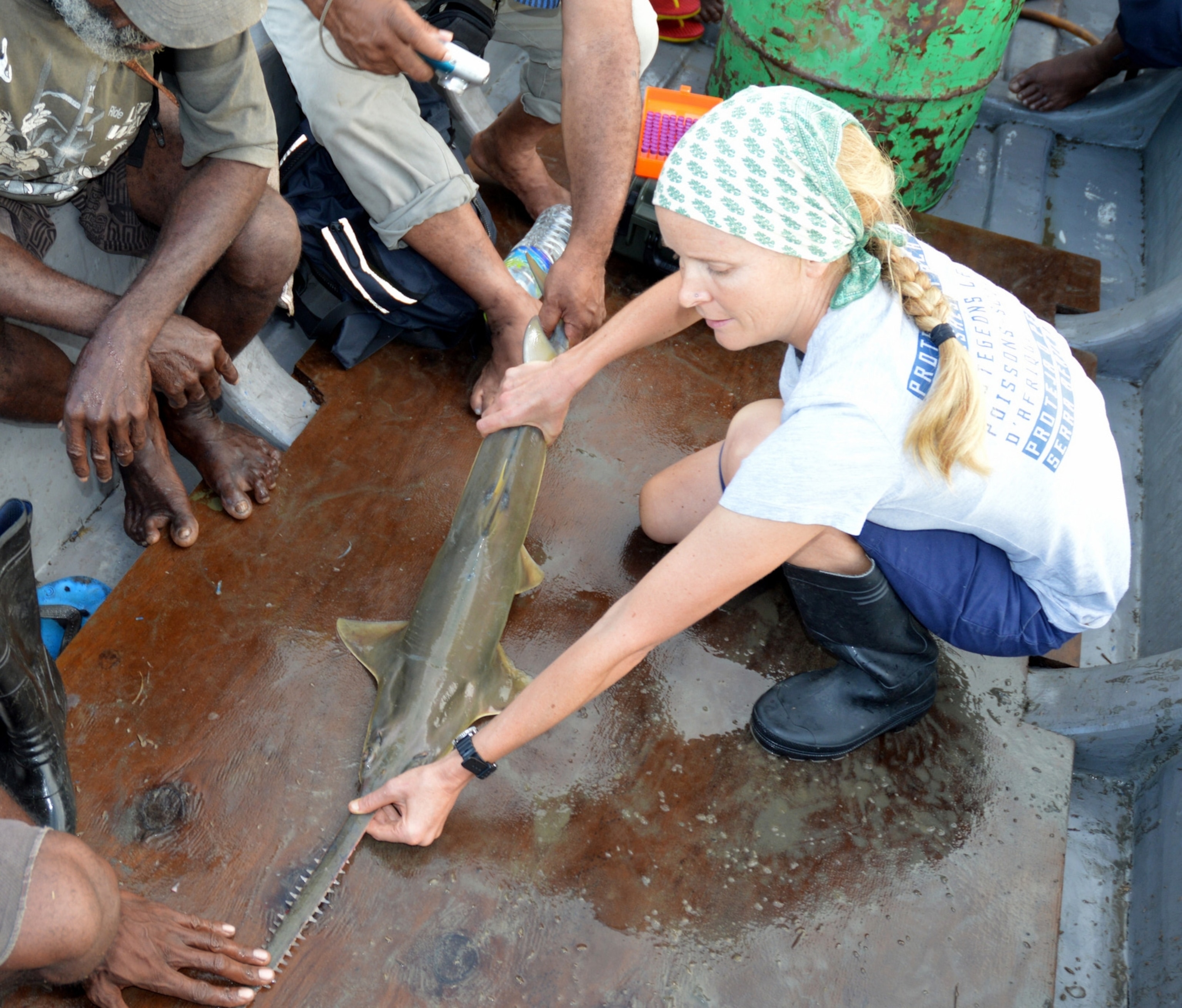Mario Espinoza has dedicated years of his life to saving a fish he has yet to see for himself in Costa Rica’s waters. It’s not for lack of trying. Every single month, the University of Costa Rica marine scientist and his team drive to the edges of one of the largest mangroves in the world, where they load onto a former fisherman’s boat and work tirelessly over three days casting nets and longlines into the murky waters of the estuary. Under the shadow of 80-foot tall mangrove trees, with crocodiles and howler monkeys for company, they seek evidence of a ghost: the largetooth sawfish.
“You retrieve the longline hook by hook, and with every hook you’re retrieving, you’re crossing your fingers thinking, ‘Oh this could be it!’” Espinoza says. From his research collecting data on sawfish captures and sightings, he knows that the Térraba-Sierpe National Wetland is one of two remaining hotspots for sawfish in Costa Rica, where they were once abundant. “We know we’re not completely on the wrong track. It’s just that they’re an endangered species. They’re very rare.”
Last year, Espinoza received word of a total of 10 confirmed sawfish sightings across the entire country.

Sawfish are large rays with long, chainsaw-like nose extensions, called rostrums, that they use to find and stun prey in murky water. They’re the most endangered of all sharks and rays—and by some measures, of all groups of marine fish. All five sawfish species are threatened with extinction despite having once spanned the tropical and subtropical waters of the Atlantic, Indian, and Pacific Oceans in large numbers. (Read about how sawfish rostra have a sixth sense.)
As slow-growing fish armed with a giant saw blade, they’re susceptible to entanglement in fishing gear in the shallow coastal waters, estuaries, and rivers beds where they dwell, as well as in deeper waters where they forage, and they’re very slow to recover from any population decline. They have legal protection in 19 countries, and their international trade is banned under the Convention on International Trade of Endangered Species (CITES), the treaty that regulates cross-border wildlife trade. As a top predator in the food chain, their loss can destabilize a coastal ecosystem.
"The quest for all of us is to find where in the world can we save these things,” says Nick Dulvy, a marine ecologist at Simon Fraser University in Vancouver. “There’s evidence of sawfishes having been present in 90 countries of the world, and at the moment we’re looking at only being able to save them in four.”
Sawfish have become locally extinct in at least 20 countries, and another 43 countries have lost at least one species of sawfish.
"It’s kind of hard to imagine that something that reaches the length of seven meters [23 feet] disappeared without us even noticing,” says Dulvy. How one of the world’s largest fish species managed to blink out from so many of the world’s waters so rapidly is a big question, but much more urgent is the question of how the world’s remaining sawfish populations can be saved.
There are two sawfish strongholds in the world: Florida, where the smalltooth sawfish is found, and northern Australia, where the world’s other four species (dwarf sawfish, narrow sawfish, largetooth sawfish, and green sawfish) persist. Outside of those two “lifeboat” populations, the future of sawfishes remains unclear. “If nothing else happens over the next decade, they’re the only two places that sawfishes are going to be left,” Dulvy says.
Researchers believe that sawfish have become locally extinct in at least 20 countries and that another 43 countries have lost at least one species of sawfish, including the United States, where the largetooth sawfish hasn’t been seen since 1961. In the few places where the fish appear to be hanging on—in the waters of Papua New Guinea, the Bahamas, Brazil, and Sudan—they face threats from ensnarement in fishing gear, poaching for the fin trade, and habitat loss.
"They get caught by way more fishing gear than almost any other species, so they’re very susceptible, combined with the fact that their fins can be worth quite a lot of money,” says Colin Simpfendorfer, a marine biologist at James Cook University in Townsville, Australia. Not only are their fins some of the most valuable in the fin trade market, but the individual teeth that stud their rostrum can fetch several hundred dollars apiece as spurs in cock fighting in Central and South America. Espinoza learned this when a black-market trader contacted him through his sawfish conservation website offering to buy them.
In the northwest Indian Ocean, Rima Jabado, founder and lead scientist with The Gulf Elasmo Project, a nonprofit based in the United Arab Emirates dedicated to saving elasmobranchs—a group that includes sharks, rays, skates, and sawfish—has spent a decade visiting fish landing sites along the Persian Gulf. Sawfishes in this region were once so abundant that fishers used their rostra to build fences around their properties. (Learn more: Smalltooth sawfish have "virgin" births.)

Now, she considers a country lucky if it lands one sawfish in a two- or three-year period. “It became very obvious very quickly that populations in this part of the world were plummeting,” Jabado says. The same narrative was playing out in central and South America, where largetooth sawfish have been decimated in Mexico, Peru, Colombia, and Venezuela, and are locally extinct in Guatemala.
A Ray of Hope in Costa Rica
Starting this year, Espinoza and his team have joined a global research collaboration to detect sawfishes by sampling water for trace amounts of sawfish DNA, known as environmental DNA or eDNA. The test has the ability to detect evidence of sawfishes over a half-mile stretch of water left behind by the fish in a three- or four-day window.
The eDNA research is part of a global sawfish eDNA hunt coordinated by Simpfendorfer to determine where researchers should focus their conservation efforts. “We want to really make sure that we focus those conservation efforts in places that we will get the best results and that we can start to see recovery in populations. The [eDNA] is really the only effective way to do this on a broad global scale,” Simpfendorfer says. In addition to Costa Rica, Simpfendorfer has sent out eDNA sampling kits to researchers in 15 other countries including Bangladesh, Pakistan, Papua New Guinea, and Australia.
Espinoza knows his quest doesn’t end at locating the fish. “From the experiences of Florida and Australia, I knew these types of conservation efforts take a lot of time, and you have to combine all the tools, like education, outreach, and research to have positive outcomes,” he says.
To that end, Espinoza has been instrumental in successfully lobbying the Costa Rican government to provide legal protection to sawfish, which it enacted in 2017. Through his national sawfish conservation initiative, En Busca del Pez Sierra - Costa Rica (“Looking for Sawfish in Costa Rica”), he and his team are raising national awareness around sawfishes and promoting education in coastal communities to teach fishers that the fish are protected and how to release and report sawfish when they do catch them.
The Lifeboat Population
An ocean away, Peter Kyne studies the four sawfish species of northern Australia. Talking to him, one gets a vivid sense of what a sawfish-friendly environment looks like. The coastline is thousands of miles long, often inaccessible by car, and largely undeveloped. Rivers swell in the monsoon season across large floodplains, creating valuable habitat for juvenile sawfishes. Fishing pressure is relatively low, and many river systems along the northern coast run wild, unfettered by dams. All of this has created a region where wildlife thrives, including sharks and rays, crocodiles, dugongs, and in-shore dolphin populations.
In recent years, Kyne, working in concert with local indigenous land and sea managers, has made multiple surprising sawfish discoveries, such as additional nursery habitat for green sawfish and the discovery of a largetooth sawfish 310 miles upriver from the ocean. “We’re really just scraping the surface of knowledge,” he admits.
In Australia, all sawfishes are legally protected. “There’s no doubt that the protection has benefited the species greatly,” says Kyne. “For example, the prawn trawl fishery in northern Australia has made some great advances since the protection of sawfish to improve the survivability of animals that are caught as bycatch,” he says.
Education campaigns have been effective at teaching recreational fishers how to safely return sawfish back into the water. “I think if we continue the protection and we continue to work closely with the commercial fisheries and continue education awareness of recreational fishers, Australia has a bright future for sawfish,” says Kyne.
Outside of Australia and Florida, countries such as Sudan, Papua New Guinea, and Bangladesh offer what Kyne refers to as “beacons of hope” for sawfishes. But those countries also have far fewer resources than Australia and the U.S. The per capita GDP in Australia is 21 times larger than that of Papua New Guinea and 35 times that of Bangladesh, for example.
Ruth Leeney, a National Geographic Explorer and scientist at the Natural History Museum in London, has worked on sawfish conservation in ten countries across Africa and Asia. She believes any lasting approach to sawfish conservation in developing countries will have to be more holistic than the top-down approach that has worked for the U.S. and Australia. “It’s not enough to set a law [to protect sawfishes] like you can in the U.S. That’s not going to work in a developing country,” she says. “There’s a lack of acknowledgement that there needs to be a diversity of ways to approach sawfish conservation that depend very much on the area, culture, and socioeconomic context of the country you’re dealing with.”
"I Have Never Seen This Animal"
Beginning in 2012, Leeney visited coastal communities along both East and West Africa with photos of sawfishes in hand. “Do you know this fish? When did you last see it?” she asked hundreds coastal fishers.
A pattern soon emerged: Older fishermen knew sawfishes firsthand, but their sons did not. “If you’d just spoken to [the sons], you’d get the impression that there had never been sawfish in that part of the world,” Leeney says. “They would look at the image [of a sawfish] and say, ‘I have never seen this animal before in my life.’” With a few exceptions in Madagascar and Mozambique, where she met fishers who had caught a sawfish in the past year or two, the story that emerged was one of loss. Africa’s sawfishes had disappeared within a period of twenty years from the waters of cultures that once knew them so intimately they featured on their currencies and in their folklore.

During Leeney’s time working in Africa, she found that the disappearance of sawfishes was linked to an equally dramatic decline of other fish in coastal waters—one that has left many subsistence fishers living in food insecurity. Fishermen whose grandfathers made a living casting a net from the shoreline were having to abandon the profession as the scarcity of fish sent them further offshore on longer and longer fishing trips.
“We have to be able to work with these communities to develop other livelihood options, because unless they have other means of making a living, they will continue to exploit resources they know have value,” she says. “The conservation value of a sawfish is meaningless to someone who is living hand-to-mouth.”
Any efforts to save sawfish will have positive effects on related issues that plague the coastal communities in many developing countries. Chief among them are food security and blue carbon, a term referring to efforts to mitigate climate change through the conservation and restoration of coastal ecosystems such as mangroves and seagrass beds.
“If you can solve the sawfish problem, you’ve solved the blue carbon and food security problem,” says Nick Dulvy. “Because if you've solved sawfish, you’ve figured out how to make tropical fisheries appropriately selective and sustainable.”









